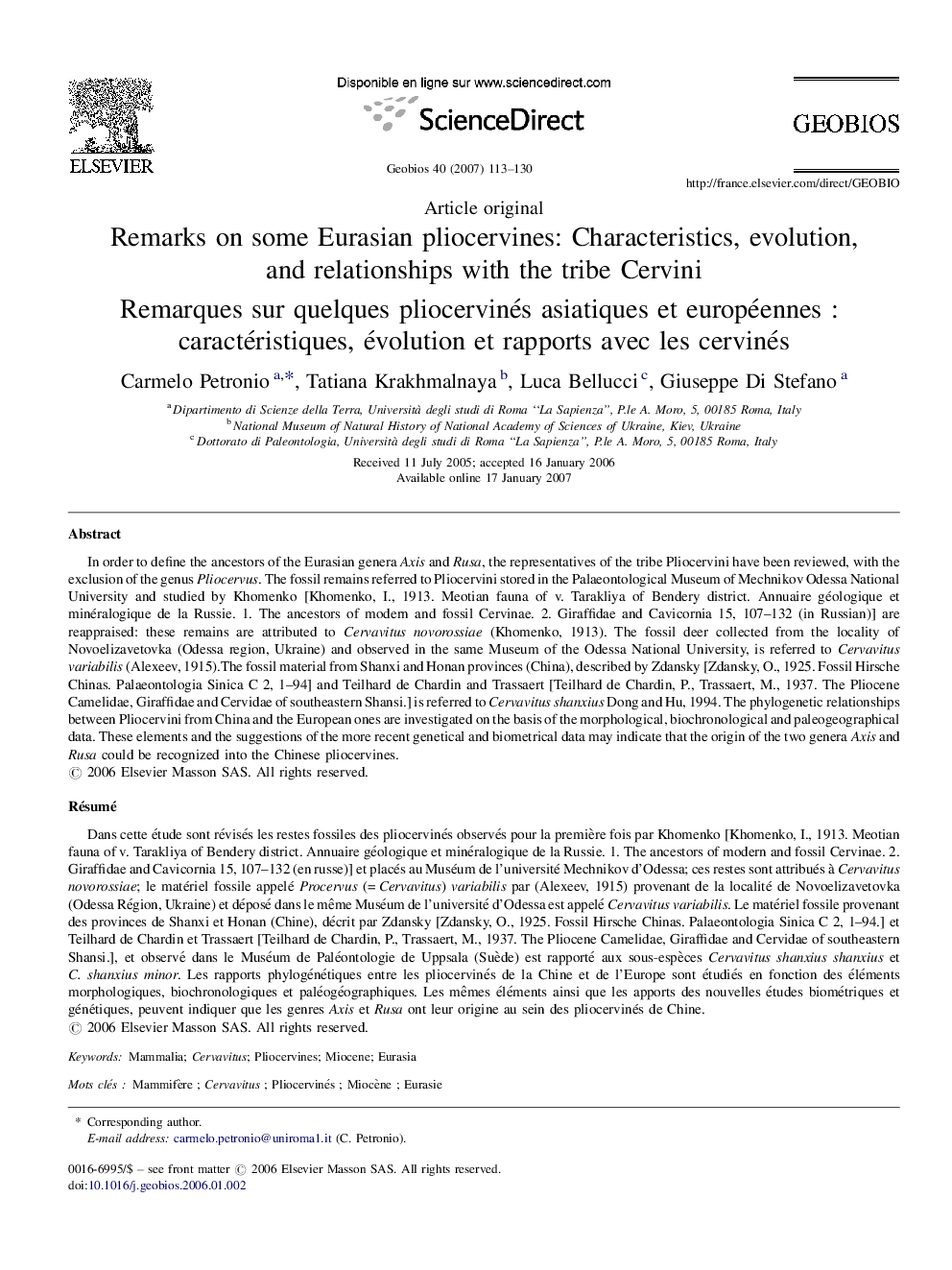| کد مقاله | کد نشریه | سال انتشار | مقاله انگلیسی | نسخه تمام متن |
|---|---|---|---|---|
| 4748710 | 1360139 | 2007 | 18 صفحه PDF | دانلود رایگان |

In order to define the ancestors of the Eurasian genera Axis and Rusa, the representatives of the tribe Pliocervini have been reviewed, with the exclusion of the genus Pliocervus. The fossil remains referred to Pliocervini stored in the Palaeontological Museum of Mechnikov Odessa National University and studied by Khomenko [Khomenko, I., 1913. Meotian fauna of v. Tarakliya of Bendery district. Annuaire géologique et minéralogique de la Russie. 1. The ancestors of modern and fossil Cervinae. 2. Giraffidae and Cavicornia 15, 107–132 (in Russian)] are reappraised: these remains are attributed to Cervavitus novorossiae (Khomenko, 1913). The fossil deer collected from the locality of Novoelizavetovka (Odessa region, Ukraine) and observed in the same Museum of the Odessa National University, is referred to Cervavitus variabilis Alexeev (1915).The fossil material from Shanxi and Honan provinces (China), described by Zdansky [Zdansky, O., 1925. Fossil Hirsche Chinas. Palaeontologia Sinica C 2, 1–94] and Teilhard de Chardin and Trassaert [Teilhard de Chardin, P., Trassaert, M., 1937. The Pliocene Camelidae, Giraffidae and Cervidae of southeastern Shansi.] is referred to Cervavitus shanxius Dong and Hu, 1994. The phylogenetic relationships between Pliocervini from China and the European ones are investigated on the basis of the morphological, biochronological and paleogeographical data. These elements and the suggestions of the more recent genetical and biometrical data may indicate that the origin of the two genera Axis and Rusa could be recognized into the Chinese pliocervines.
RésuméDans cette étude sont révisés les restes fossiles des pliocervinés observés pour la première fois par Khomenko [Khomenko, I., 1913. Meotian fauna of v. Tarakliya of Bendery district. Annuaire géologique et minéralogique de la Russie. 1. The ancestors of modern and fossil Cervinae. 2. Giraffidae and Cavicornia 15, 107–132 (en russe)] et placés au Muséum de l’université Mechnikov d’Odessa; ces restes sont attribués à Cervavitus novorossiae; le matériel fossile appelé Procervus (= Cervavitus) variabilis par Alexeev (1915) provenant de la localité de Novoelizavetovka (Odessa Région, Ukraine) et déposé dans le même Muséum de l’université d’Odessa est appelé Cervavitus variabilis. Le matériel fossile provenant des provinces de Shanxi et Honan (Chine), décrit par Zdansky [Zdansky, O., 1925. Fossil Hirsche Chinas. Palaeontologia Sinica C 2, 1–94.] et Teilhard de Chardin et Trassaert [Teilhard de Chardin, P., Trassaert, M., 1937. The Pliocene Camelidae, Giraffidae and Cervidae of southeastern Shansi.], et observé dans le Muséum de Paléontologie de Uppsala (Suède) est rapporté aux sous-espèces Cervavitus shanxius shanxius et C. shanxius minor. Les rapports phylogénétiques entre les pliocervinés de la Chine et de l’Europe sont étudiés en fonction des éléments morphologiques, biochronologiques et paléogéographiques. Les mêmes éléments ainsi que les apports des nouvelles études biométriques et génétiques, peuvent indiquer que les genres Axis et Rusa ont leur origine au sein des pliocervinés de Chine.
Journal: Geobios - Volume 40, Issue 1, January–February 2007, Pages 113–130